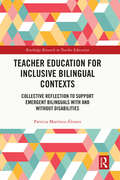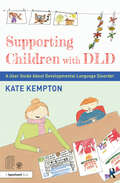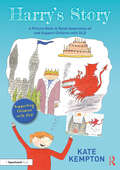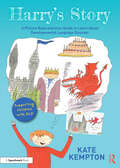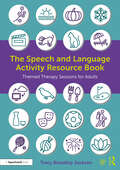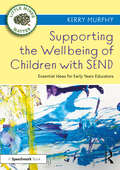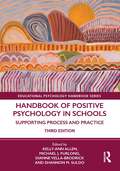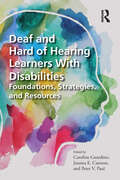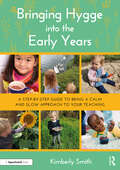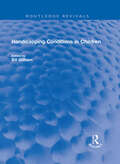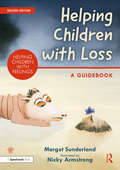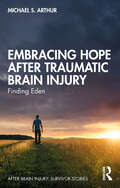- Table View
- List View
Teacher Education for Inclusive Bilingual Contexts: Collective Reflection to Support Emergent Bilinguals with and without Disabilities (Routledge Research in Teacher Education)
by Patricia Martínez-ÁlvarezThis text demonstrates how collective reflection can function as a central part of effective teacher preparation for work in inclusive bilingual environments. Through analysis of rich qualitative data, Teacher Education for Inclusive Bilingual Contexts shows how group reflection supports pre-service educators to recognize the intersectional challenges faced by students, and understand their identities beyond the confines of disability. This, in turn, engenders reconceptualization of standardized expectations and implicates the educator in developing student agency through individualized use of routine, language, and materials. The author offers Cultural Historical Activity Theory (CHAT) and Disability Studies in Education (DSE) as a basis for dialectal interactions to unearth contradictions and misunderstandings surrounding language acquisition and the learning of emergent bilinguals, and highlight the ways in which educators can disrupt oppressive practices through expansive learning practices. This insightful volume will be of interest to researchers, scholars, and postgraduate students in the fields of inclusive education and disability studies, bilingual and language education, and teacher education.
Teacher Education for Inclusive Bilingual Contexts: Collective Reflection to Support Emergent Bilinguals with and without Disabilities (Routledge Research in Teacher Education)
by Patricia Martínez-ÁlvarezThis text demonstrates how collective reflection can function as a central part of effective teacher preparation for work in inclusive bilingual environments. Through analysis of rich qualitative data, Teacher Education for Inclusive Bilingual Contexts shows how group reflection supports pre-service educators to recognize the intersectional challenges faced by students, and understand their identities beyond the confines of disability. This, in turn, engenders reconceptualization of standardized expectations and implicates the educator in developing student agency through individualized use of routine, language, and materials. The author offers Cultural Historical Activity Theory (CHAT) and Disability Studies in Education (DSE) as a basis for dialectal interactions to unearth contradictions and misunderstandings surrounding language acquisition and the learning of emergent bilinguals, and highlight the ways in which educators can disrupt oppressive practices through expansive learning practices. This insightful volume will be of interest to researchers, scholars, and postgraduate students in the fields of inclusive education and disability studies, bilingual and language education, and teacher education.
Supporting Children with DLD: A User Guide About Developmental Language Disorder (Supporting Children with DLD)
by Kate KemptonFor effective use, this book should be purchased alongside the illustrated picture book Harry’s Story. Both books can be purchased together as a set, Supporting Children with DLD: A Picture Book and User Guide to Learn About Developmental Language Disorder [978-0-367-70920-4]. Supporting Children with DLD, has been developed to help raise awareness of Developmental Language Disorder, and to highlight the impact of the condition from the child’s point of view. With activities, prompts and sample questions, this is an essential resource to enable adults to understand the reality of living with DLD, helping children feel heard and respected, as well as providing a solid foundation for tailoring support to individual needs. Drawing on specific examples from Harry’s Story, the book does not assume any prior knowledge of DLD and is designed to offer the reader accessible information and practical advice, teaching as you go. This book: Highlights the link between spoken and written language, addressing the need to recognise the literary difficulties faced by children with DLD Provides practical activities and worksheets that can be used to help children express themselves and ask for help Offers strategies for supporting children’s understanding of language, based on common situations and experiences explored in Harry’s Story Written to be an accessible introduction to DLD and its effect on children’s lives, this is an essential resource for parents and professionals looking to understand the condition.
Harry's Story: A Picture Book to Raise Awareness of and Support Children with DLD (Supporting Children with DLD)
by Kate KemptonFor effective use, this book can be purchased alongside the professional guide, Supporting Children with DLD. Both books can be purchased together as a set, Supporting Children with DLD: A Picture Book and User Guide to Learn About Developmental Language Disorder [978-0-367-70920-4]. This beautifully illustrated picture book has been created to develop awareness of Developmental Language Disorder and provides a unique opportunity to sensitively gain children’s perspectives of the condition. Harry enjoys school, but faces daily challenges due to his language difficulties. When he is asked to write a story, he struggles to find the words to put his thoughts onto paper. He learns to share his stories through pictures instead and, in doing so, helps his supportive teacher understand what she can do to make life easier for him. With bright illustrations and language that can be accessed by children with DLD, this story can be used to start conversations about the lived experience of children with Developmental Language Disorder, giving them a voice and helping them express their thoughts and feelings. It can also be used as a training tool for teachers and other professionals. This is an essential resource for parents and practitioners looking to understand and support children with DLD.
Supporting Children with DLD: A User Guide About Developmental Language Disorder (Supporting Children with DLD)
by Kate KemptonFor effective use, this book should be purchased alongside the illustrated picture book Harry’s Story. Both books can be purchased together as a set, Supporting Children with DLD: A Picture Book and User Guide to Learn About Developmental Language Disorder [978-0-367-70920-4]. Supporting Children with DLD, has been developed to help raise awareness of Developmental Language Disorder, and to highlight the impact of the condition from the child’s point of view. With activities, prompts and sample questions, this is an essential resource to enable adults to understand the reality of living with DLD, helping children feel heard and respected, as well as providing a solid foundation for tailoring support to individual needs. Drawing on specific examples from Harry’s Story, the book does not assume any prior knowledge of DLD and is designed to offer the reader accessible information and practical advice, teaching as you go. This book: Highlights the link between spoken and written language, addressing the need to recognise the literary difficulties faced by children with DLD Provides practical activities and worksheets that can be used to help children express themselves and ask for help Offers strategies for supporting children’s understanding of language, based on common situations and experiences explored in Harry’s Story Written to be an accessible introduction to DLD and its effect on children’s lives, this is an essential resource for parents and professionals looking to understand the condition.
Harry's Story: A Picture Book to Raise Awareness of and Support Children with DLD (Supporting Children with DLD)
by Kate KemptonFor effective use, this book can be purchased alongside the professional guide, Supporting Children with DLD. Both books can be purchased together as a set, Supporting Children with DLD: A Picture Book and User Guide to Learn About Developmental Language Disorder [978-0-367-70920-4]. This beautifully illustrated picture book has been created to develop awareness of Developmental Language Disorder and provides a unique opportunity to sensitively gain children’s perspectives of the condition. Harry enjoys school, but faces daily challenges due to his language difficulties. When he is asked to write a story, he struggles to find the words to put his thoughts onto paper. He learns to share his stories through pictures instead and, in doing so, helps his supportive teacher understand what she can do to make life easier for him. With bright illustrations and language that can be accessed by children with DLD, this story can be used to start conversations about the lived experience of children with Developmental Language Disorder, giving them a voice and helping them express their thoughts and feelings. It can also be used as a training tool for teachers and other professionals. This is an essential resource for parents and practitioners looking to understand and support children with DLD.
Supporting Children with DLD: A Picture Book and User Guide to Learn About Developmental Language Disorder (Supporting Children with DLD)
by Kate KemptonThis picture book and guidebook set has been developed to help raise awareness of Developmental Language Disorder, and to highlight the impact of DLD from the child’s point of view. Harry’s Story introduces a child who faces daily challenges in school due to his language difficulties. It explores how these challenges are made easier by his teachers’ understanding and support as he finds new ways to communicate. Supporting Children with DLD provides essential information, prompts and suggestions for adults to help understand the experience of children with DLD. It offers supportive strategies and activities to help children express themselves effectively and ask for help when they need it. This resource can be used both directly with the child, to talk about and explore DLD, and also as a training tool with the parents and professionals who support them. With research suggesting an average of two children per classroom are affected by DLD, this is an essential set for parents and professionals looking to understand the condition.
Supporting Children with DLD: A Picture Book and User Guide to Learn About Developmental Language Disorder (Supporting Children with DLD)
by Kate KemptonThis picture book and guidebook set has been developed to help raise awareness of Developmental Language Disorder, and to highlight the impact of DLD from the child’s point of view. Harry’s Story introduces a child who faces daily challenges in school due to his language difficulties. It explores how these challenges are made easier by his teachers’ understanding and support as he finds new ways to communicate. Supporting Children with DLD provides essential information, prompts and suggestions for adults to help understand the experience of children with DLD. It offers supportive strategies and activities to help children express themselves effectively and ask for help when they need it. This resource can be used both directly with the child, to talk about and explore DLD, and also as a training tool with the parents and professionals who support them. With research suggesting an average of two children per classroom are affected by DLD, this is an essential set for parents and professionals looking to understand the condition.
The Speech and Language Activity Resource Book: Themed Therapy Sessions for Adults
by Tracy Broadley JacksonThe Speech and Language Activity Resource Book offers a flexible and readily available set of activities and worksheets designed to support speech and language therapists as they deliver personalised and engaging therapy sessions. With topics based on seasons, hobbies, sports and celebrations, etc, the worksheets can be selected to suit a client’s interests as well as targeting specific skills and needs. The engaging activities encourage conversation and participation, promoting skill development in a way that is easily translated into everyday communication. Key features of this book include: A range of activities, arranged by level of difficulty, that can be selected based on the client’s individual need A person-centred approach to therapy, enabling the time-poor practitioner the opportunity to personalise their care with ease Photocopiable and downloadable sheets that can be completed during therapy sessions or sent out to the client for home practice, as well as blank worksheets that can be used to create new, appropriate activities Easily adaptable for group sessions, one-on-one therapy sessions and home activities, this is an essential tool for speech and language therapists and occupational therapists, as well as families and other practitioners supporting adults with a range of acquired communication difficulties.
The Speech and Language Activity Resource Book: Themed Therapy Sessions for Adults
by Tracy Broadley JacksonThe Speech and Language Activity Resource Book offers a flexible and readily available set of activities and worksheets designed to support speech and language therapists as they deliver personalised and engaging therapy sessions. With topics based on seasons, hobbies, sports and celebrations, etc, the worksheets can be selected to suit a client’s interests as well as targeting specific skills and needs. The engaging activities encourage conversation and participation, promoting skill development in a way that is easily translated into everyday communication. Key features of this book include: A range of activities, arranged by level of difficulty, that can be selected based on the client’s individual need A person-centred approach to therapy, enabling the time-poor practitioner the opportunity to personalise their care with ease Photocopiable and downloadable sheets that can be completed during therapy sessions or sent out to the client for home practice, as well as blank worksheets that can be used to create new, appropriate activities Easily adaptable for group sessions, one-on-one therapy sessions and home activities, this is an essential tool for speech and language therapists and occupational therapists, as well as families and other practitioners supporting adults with a range of acquired communication difficulties.
Supporting the Wellbeing of Children with SEND: Essential Ideas for Early Years Educators (Little Minds Matter)
by Kerry MurphyAs an early years practitioner, you will educate and care for children with a range of developmental needs and differences. This essential book introduces you to a play-rich approach providing both universal and targeted ideas that will support social and emotional development and ensure that children feel safe, secure, and nurtured. Using the four broad areas of need as a guide, each accessible chapter positions wellbeing at the heart of an effective approach to inclusion and offers meaningful and responsive teaching practices that create a sense of belonging and acceptance. Founded in the latest research, the book presents key knowledge alongside ideas and activities to support wellbeing, which can be embedded into the child’s everyday experiences and adapted to meet their individual needs. This book offers: Evidence-based strategies and techniques that have a positive impact on the long-term social and emotional wellbeing of children with SEND. Guidance through the four broad areas of need, with a focus on play, learning, and developing an emotionally healthy early years environment. Examples of practice in action. Case studies, reflective questions, and activities that will upskill the reader and empower them in their role. Providing up to date, transferrable and essential knowledge on SEND in the early years, this is an essential resource for any practitioner looking to expand their repertoire and enrich the wellbeing of children with SEND.
Supporting the Wellbeing of Children with SEND: Essential Ideas for Early Years Educators (Little Minds Matter)
by Kerry MurphyAs an early years practitioner, you will educate and care for children with a range of developmental needs and differences. This essential book introduces you to a play-rich approach providing both universal and targeted ideas that will support social and emotional development and ensure that children feel safe, secure, and nurtured. Using the four broad areas of need as a guide, each accessible chapter positions wellbeing at the heart of an effective approach to inclusion and offers meaningful and responsive teaching practices that create a sense of belonging and acceptance. Founded in the latest research, the book presents key knowledge alongside ideas and activities to support wellbeing, which can be embedded into the child’s everyday experiences and adapted to meet their individual needs. This book offers: Evidence-based strategies and techniques that have a positive impact on the long-term social and emotional wellbeing of children with SEND. Guidance through the four broad areas of need, with a focus on play, learning, and developing an emotionally healthy early years environment. Examples of practice in action. Case studies, reflective questions, and activities that will upskill the reader and empower them in their role. Providing up to date, transferrable and essential knowledge on SEND in the early years, this is an essential resource for any practitioner looking to expand their repertoire and enrich the wellbeing of children with SEND.
Handbook of Positive Psychology in Schools: Supporting Process and Practice (Educational Psychology Handbook)
by Kelly-Ann Allen Michael J. Furlong Dianne Vella-Brodrick Shannon M. SuldoThe Handbook of Positive Psychology in Schools offers the most current and comprehensive insights into how positive psychology principles provide a framework for young people to become active agents in their own learning. The third edition of this groundbreaking volume assembles the latest global research identifying fundamental assets—hope, optimism, gratitude, self-efficacy, emotional regulation, among others—that support students’ learning and well-being. Chapters examining social-ecological perspectives on classroom quality and school climate provide best practice guidance on schoolwide policies and practices. These 35 new chapters explore positive psychology’s ongoing influence and advances on prevention, intervention, and assessment practices in schools.
Handbook of Positive Psychology in Schools: Supporting Process and Practice (Educational Psychology Handbook)
by Kelly-Ann AllenThe Handbook of Positive Psychology in Schools offers the most current and comprehensive insights into how positive psychology principles provide a framework for young people to become active agents in their own learning. The third edition of this groundbreaking volume assembles the latest global research identifying fundamental assets—hope, optimism, gratitude, self-efficacy, emotional regulation, among others—that support students’ learning and well-being. Chapters examining social-ecological perspectives on classroom quality and school climate provide best practice guidance on schoolwide policies and practices. These 35 new chapters explore positive psychology’s ongoing influence and advances on prevention, intervention, and assessment practices in schools.
Deaf and Hard of Hearing Learners With Disabilities: Foundations, Strategies, and Resources
by Caroline Guardino Joanna E. Cannon Peter V. PaulThis volume offers foundational information and research-based strategies for meeting the needs of deaf and hard of hearing learners with disabilities. The disabilities covered in this volume include developmental delays, autism spectrum disorder, intellectual and learning disabilities, deafblindness, emotional and behavioral disorders, attention deficit hyperactivity disorder, and a variety of high incidence syndromes. Contributors examine the literature within each disability category, share best practices, and consider demographics/characteristics, intervention/identification, placement, communication/language, psychosocial issues, assistive technologies/accommodations, assessments, and transition/post-secondary outcomes. Each chapter begins with learning objectives and concludes with discussion questions and a resource list. Deaf and Hard of Hearing Learners with Disabilities is an essential book for courses at the undergraduate and graduate level, and in workshops and webinars for in-service teachers, professionals, and families.
Deaf and Hard of Hearing Learners With Disabilities: Foundations, Strategies, and Resources
by Caroline Guardino Joanna E. Cannon Peter V. PaulThis volume offers foundational information and research-based strategies for meeting the needs of deaf and hard of hearing learners with disabilities. The disabilities covered in this volume include developmental delays, autism spectrum disorder, intellectual and learning disabilities, deafblindness, emotional and behavioral disorders, attention deficit hyperactivity disorder, and a variety of high incidence syndromes. Contributors examine the literature within each disability category, share best practices, and consider demographics/characteristics, intervention/identification, placement, communication/language, psychosocial issues, assistive technologies/accommodations, assessments, and transition/post-secondary outcomes. Each chapter begins with learning objectives and concludes with discussion questions and a resource list. Deaf and Hard of Hearing Learners with Disabilities is an essential book for courses at the undergraduate and graduate level, and in workshops and webinars for in-service teachers, professionals, and families.
Bringing Hygge into the Early Years: A Step-by-Step Guide to Bring a Calm and Slow Approach to Your Teaching
by Kimberly SmithBringing Hygge into the Early Years is a “how-to” guide for every early educator who wishes to bring more calmness and balance into their day, in turn, leaving them feeling empowered to teach and live well. Drawing from the author’s experience of embracing the Scandinavian way of living well, “hygge,” this book explores how this approach can have a positive impact across your early years setting, from improved mental health and wellbeing, to embracing child-led play and high-quality outdoor provision. With step-by-step guidance on how to embed the approach alongside examples of hygge from early educators around the world, the book is divided into four main parts: Re-balance you The hygge environment Slow teaching Embracing nature Throughout each chapter, case studies and activities provide the opportunity to reflect on existing practice and support you as you make positive changes to both your wellbeing and provision. This guide will be essential reading for all early years professionals, offering further support to improve mental health and wellbeing, as well as valuable tools to lead early years practice with confidence and joy.
Bringing Hygge into the Early Years: A Step-by-Step Guide to Bring a Calm and Slow Approach to Your Teaching
by Kimberly SmithBringing Hygge into the Early Years is a “how-to” guide for every early educator who wishes to bring more calmness and balance into their day, in turn, leaving them feeling empowered to teach and live well. Drawing from the author’s experience of embracing the Scandinavian way of living well, “hygge,” this book explores how this approach can have a positive impact across your early years setting, from improved mental health and wellbeing, to embracing child-led play and high-quality outdoor provision. With step-by-step guidance on how to embed the approach alongside examples of hygge from early educators around the world, the book is divided into four main parts: Re-balance you The hygge environment Slow teaching Embracing nature Throughout each chapter, case studies and activities provide the opportunity to reflect on existing practice and support you as you make positive changes to both your wellbeing and provision. This guide will be essential reading for all early years professionals, offering further support to improve mental health and wellbeing, as well as valuable tools to lead early years practice with confidence and joy.
Handicapping Conditions in Children (Routledge Revivals)
by Bill GillhamFirst published in 1986, Handicapping Conditions in Children provides an accessible overview of a wide range of handicapping conditions and their remediation, and gives a balanced perspective on the medical, educational and social issues. It will therefore be of value to a wide audience in these professions as well as to students and parents. Each chapter deals with one specific area but is presented to cover: description of the condition and its aetiology; its prevalence in the population and relatives; developmental characteristics; special problems and needs; educational and social provision; the potential for the future; and further reading lists. The book does not include every possible condition, but concentrates on those that are most frequent or problematic. This book is a reissue originally published in 1986. The language used is a reflection of its era and no offence is meant by the Publishers to any reader by this republication
Handicapping Conditions in Children (Routledge Revivals)
by Bill GillhamFirst published in 1986, Handicapping Conditions in Children provides an accessible overview of a wide range of handicapping conditions and their remediation, and gives a balanced perspective on the medical, educational and social issues. It will therefore be of value to a wide audience in these professions as well as to students and parents. Each chapter deals with one specific area but is presented to cover: description of the condition and its aetiology; its prevalence in the population and relatives; developmental characteristics; special problems and needs; educational and social provision; the potential for the future; and further reading lists. The book does not include every possible condition, but concentrates on those that are most frequent or problematic. This book is a reissue originally published in 1986. The language used is a reflection of its era and no offence is meant by the Publishers to any reader by this republication
Helping Children with Loss: A Guidebook (Helping Children with Feelings)
by Margot Sunderland Nicky ArmstrongNow in a fully updated second edition, this professional guidebook has been created to help adults provide emotional support for children who have experienced the loss of somebody they know, or something they loved. Written in an accessible style and with a sensitive tone, Helping Children with Loss provides adults with a rich vocabulary for mental states and painful emotions, paving the way for meaningful and healing conversations with children who are struggling with difficult feelings. Practical activities provide opportunities for conversation and will empower the child to find creative and imaginative ways of expressing themselves when words fail. Key features of this resource include: Targeted advice for children who defend against feeling their painful feelings by dissociating from grief Tools and strategies for helping children cope with loss, including engaging activities to help children explore their feelings in a non-threatening way Photocopiable and downloadable resources to help facilitate support Written by a leading child psychotherapist with over thirty years’ experience, this book will support children to develop emotional literacy and connect with unresolved feelings affecting their behaviour. It is an essential resource for anybody supporting children aged 4-12 who have experienced loss.
The Day the Sea Went Out and Never Came Back: A Story for Children Who Have Lost Someone They Love (Helping Children with Feelings)
by Margot Sunderland Nicky ArmstrongEric is a sand dragon who loves the sea very much. Each day, he watches it go out, knowing that it will return. But one day, Eric waits and waits, but it does not come back. He falls on the sand, feeling as if he has lost everything. Eric wants to shut himself off from his feelings, but eventually spots a little wildflower growing, and another, and another. He builds a rock pool garden, in memory of the sea that he loves, and learns that it is much better to feel the full pain of his loss, instead of closing his heart. The Day the Sea Went Out and Never Came Back is a story for children who have lost someone they love. The beautiful illustrations and sensitively written story offer a wealth of opportunities to begin a conversation about the difficult emotions that can follow a loss, helping children to acknowledge and express their emotions. The story shows them that it is brave to feel sad, that they are surrounded by support, and that memories of a loved one are a special treasure that can never be lost. Ideal for starting conversations about grief and sadness, this is an essential resource for anybody supporting children aged 4-12 who have experienced loss.
Helping Children with Loss: A Guidebook (Helping Children with Feelings)
by Margot Sunderland Nicky ArmstrongNow in a fully updated second edition, this professional guidebook has been created to help adults provide emotional support for children who have experienced the loss of somebody they know, or something they loved. Written in an accessible style and with a sensitive tone, Helping Children with Loss provides adults with a rich vocabulary for mental states and painful emotions, paving the way for meaningful and healing conversations with children who are struggling with difficult feelings. Practical activities provide opportunities for conversation and will empower the child to find creative and imaginative ways of expressing themselves when words fail. Key features of this resource include: Targeted advice for children who defend against feeling their painful feelings by dissociating from grief Tools and strategies for helping children cope with loss, including engaging activities to help children explore their feelings in a non-threatening way Photocopiable and downloadable resources to help facilitate support Written by a leading child psychotherapist with over thirty years’ experience, this book will support children to develop emotional literacy and connect with unresolved feelings affecting their behaviour. It is an essential resource for anybody supporting children aged 4-12 who have experienced loss.
Embracing Hope After Traumatic Brain Injury: Finding Eden (After Brain Injury: Survivor Stories)
by Michael S. ArthurThis important book provides a firsthand account of a university professor who experienced traumatic brain injury. It tells the story of Michael Arthur, who had recently accepted a position as vice principal of a new high school. After only two weeks on the job, he was involved in a car accident while driving through an intersection in northern Utah. Through his personal account, he takes the reader into the dark interworkings of his mind as he tries to cope with his new reality. He provides insight into how he learned how to process information and even speak without stumbling on his words while also sharing how his significant relationships suffered as he tried to navigate the restless seas of doubt while trying to circumvent his unyielding symptoms. The book is about finding optimism and gaining insight into the struggles of the brain-injured patient and about trying to understand the perspectives of loved ones who can’t quite grasp the idea of an invisible injury. From the sudden onset of garbled speech to the challenges of processing information, the changing dynamic of the author’s life is highlighted to help family members and healthcare workers better understand.
Embracing Hope After Traumatic Brain Injury: Finding Eden (After Brain Injury: Survivor Stories)
by Michael S. ArthurThis important book provides a firsthand account of a university professor who experienced traumatic brain injury. It tells the story of Michael Arthur, who had recently accepted a position as vice principal of a new high school. After only two weeks on the job, he was involved in a car accident while driving through an intersection in northern Utah. Through his personal account, he takes the reader into the dark interworkings of his mind as he tries to cope with his new reality. He provides insight into how he learned how to process information and even speak without stumbling on his words while also sharing how his significant relationships suffered as he tried to navigate the restless seas of doubt while trying to circumvent his unyielding symptoms. The book is about finding optimism and gaining insight into the struggles of the brain-injured patient and about trying to understand the perspectives of loved ones who can’t quite grasp the idea of an invisible injury. From the sudden onset of garbled speech to the challenges of processing information, the changing dynamic of the author’s life is highlighted to help family members and healthcare workers better understand.
